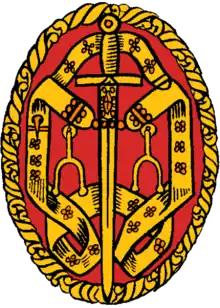Knight Bachelor
The title of Knight Bachelor is the basic rank granted to a man who has been knighted by the monarch but not inducted as a member of one of the organised orders of chivalry; it is a part of the British honours system.[1] Knights Bachelor are the most ancient sort of British knight[2] (the rank existed during the 13th-century reign of King Henry III), but Knights Bachelor rank below knights of chivalric orders. A man who is knighted is formally addressed as "Sir [First Name] [Surname]" or "Sir [First Name]" and his wife as "Lady [Surname]".
| Knight Bachelor | |
|---|---|
 The insignia of a knight bachelor devised in 1926 | |
| Awarded by Monarch of the United Kingdom | |
| Awarded for | Public service |
| Status | Currently constituted |
| Sovereign | Charles III |
| Knight Principal | Sir Gary Hickinbottom |
Ribbon bar of the Knight Bachelor Medal | |
Criteria
Knighthood is usually conferred for public service; amongst its recipients are all male judges of His Majesty's High Court of Justice in England. It is possible to be a Knight Bachelor and a junior member of an order of chivalry without being a knight of that order; this situation has become rather common, especially among those recognized for achievements in entertainment. For instance, Sir Michael Gambon, Sir Brian May, Sir Mo Farah, Sir Derek Jacobi, Sir Anthony Hopkins, Sir Elton John, Sir Michael Caine, Sir Billy Connolly, Sir Barry Gibb and Sir Ian McKellen are Commanders of the Most Excellent Order of the British Empire (CBEs); Sir Patrick Stewart, Sir Cliff Richard, Sir Tom Jones and Sir Van Morrison are Officers of the Most Excellent Order of the British Empire (OBEs); while Sir Paul McCartney, Sir Richard Starkey (Ringo Starr), and Sir Nick Faldo are Members of the Most Excellent Order of the British Empire (MBE). None of them would be entitled to use the honorific "Sir" by virtue of their membership of the order alone, but as they are all also Knights Bachelor, they are entitled to preface their names with that title.
Honorifics and post-nominal letters
Knights Bachelor may prefix "Sir" to their forenames, and wives of Knights may prefix "Lady" to their surnames.[1][3][4] The award originated in the Middle Ages. There are no post-nominal letters associated with the honour nor can it be awarded to women (they are appointed Dames Commander of the Order of the British Empire instead).[5]
Insignia
Until 1926, Knights Bachelor had no insignia which they could wear, but in that year King George V issued a warrant authorising the wearing of a badge on all appropriate occasions by Knights Bachelor; this badge is worn on the left side of the coat or outer garment. Measuring 2+3⁄8 inches (60 mm) in length and 1+3⁄8 inches (35 mm) in width, it is described in heraldic terms as follows:[6]
Upon an oval medallion of vermilion, enclosed by a scroll a cross-hilted sword belted and sheathed, pommel upwards, between two spurs, rowels upwards, the whole set about with the sword belt, all gilt.
In 1974, Queen Elizabeth II issued a further warrant authorising the wearing on appropriate occasions of a neck badge, slightly smaller, and in miniature. In 1988, a new certificate of authentication, a knight's only personal documentation, was designed by the College of Arms.[6]
Imperial Society of Knights Bachelor
The Imperial Society of Knights Bachelor[7] was founded for the maintenance and consolidation of the Dignity of Knights Bachelor in 1908, and obtained official recognition from the Sovereign in 1912. The Society keeps records of all Knights Bachelor, in their interest.
Equivalence
There is no female counterpart to Knight Bachelor. The lowest knightly honour that can be conferred upon a woman is Dame Commander of the Most Excellent Order of the British Empire (DBE), which is one rank higher than Knight Bachelor (being the female equivalent of KBE or Knight Commander of the Most Excellent Order of the British Empire, which is the next male knightly rank above Knight Bachelor).
Only citizens of Commonwealth realms can be created Knights Bachelor; people of other nationalities are generally made honorary KBEs.[8]
See also
Notes
- "The British Honours System". www.churchill-society-london.org.uk. Retrieved 23 May 2017.
- Neave, F.G.; Turner, Grange (1930). Mozley & Whiteley's Law Dictionary (5th ed.). London: Butterworth & Co. p. 183.
- "Form of address". Imperial Society of Knights Bachelor. Retrieved 17 April 2014.
- "Knight Bachelor". Forms of address. Debrett's. Archived from the original on 5 April 2014. Retrieved 17 April 2014.
- "Orders of Chivalry". British Government. Archived from the original on 19 August 2007. Retrieved 30 August 2007.
- Debrett's Peerage & Baronetage 2019. Debrett's. 2019. ISBN 9781999767006.
- "Imperial Society of Knights Bachelor". Heraldry of the World. Retrieved 3 February 2021.
- "Imperial Society of Knights Bachelor". www.iskb.co.uk. Retrieved 23 May 2017.
References
- Insignia of knights bachelor—Website of the Imperial Society of Knights Bachelor
- The UK Honours System—Website UK Government
- Debrett's
External links
 Media related to Knights Bachelor at Wikimedia Commons
Media related to Knights Bachelor at Wikimedia Commons